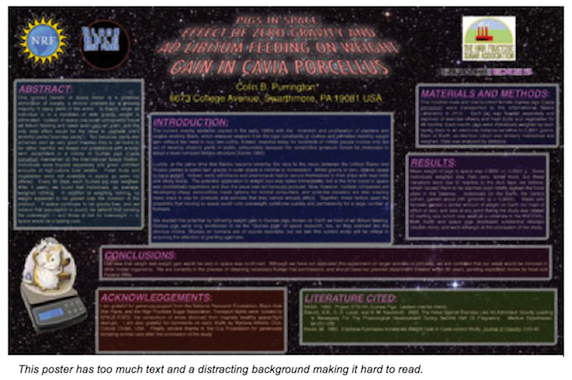Poster Guide
 |
7 KEY STEPS:
|
- Know the audience: are they specialist to the topic, related to the field or the general public.
- Make sure you are familiar with everything, if the poster is presented with you in attendance you need to be comfortable answering questions related to both the content of the poster and related theory.
 2. Keep the size to between 500 and 1000 words:
2. Keep the size to between 500 and 1000 words:
- More words affect readability (font size has to be smaller) and also makes it too overwhelming.
- Limiting it to 500-1000 works makes it easier for a person unfamiliar with the content to understand it quickly.
- Use consistent styles. Also remember that the poster is printed as A4 and blown up to A1/A0 so consider font size.
- Text that belongs together is grouped together; usually achieved by paragraph spacing.
- Consider line spacing (this should be increased slightly for body text to make it easier to read; however compressed line spacing can be beneficial for titles), alignment (left) and text formatting (use the same font throughout).
- All your headings should be in bold. Use italics, underlining and capitals sparingly and make sure to break up any large blocks of text with subtitles.
- Photographs - need to be relevant, referenced and have an appropriate resolution.
- Diagrams convey information quickly so are very useful in helping cut down the word count.
- You need to think about the formatting of graphs and tables being seen from a distance - This is also important when considering presentation slides.
- Audience needs to understand the sequence.
- It should follow a conventional scientific report pattern: introduction, method, results, conclusions and references.
- It can be helpful to use a design grid.
- Needs to be engaging particularly important if you want it to attract the audience’s attention in a poster session.
- Need to decide if you want the poster to be landscape or portrait.
- Choose colours that are already represented in your images.
- Alternatively you can choose colours from a colour wheel.
- Small mistakes at A4 become large mistakes at A1/A0.
- On poster creation - "Study & Communication Skills for the Chemical Sciences", Tina Overton et al, Chapter 15, OUP (2015).
- On the poster required for the Year 2 Semester 2 Quantum Dots practical -
- You can use the University of Southampton template or create your own poster in Word or PowerPoint.
- The poster that you create will need to be submitted electronically, with the deadline for submission being the same as that for a lab report.
- Also see the lab script for further details.